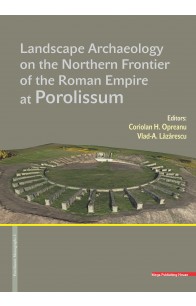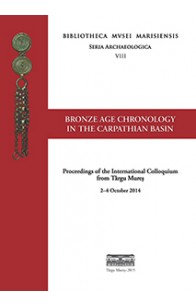Rezultate căutare pentru 'Adrian Arde��'
„În urmă cu mai bine de 30 de ani, în timpul uceniciei pe șantierele arheologice ale profesorului Gheorghe Lazarovici, ne-am întâlnit pentru prima dată cu studiile interdisciplinare între arheologie și etnografie, religie etc. La vremea respectivă am considerat aceste inițiative drept un pionierat fără o finalitate în cercetarea fundamentală. La cercetările organizate de profesorul Gheorghe Lazarovici am avut onoarea să-l cunosc pe John Nandriș, care ne-a descchis drumul către această cercetare interdisciplinară. Remarc în mod deosebit aportul de nepreţuit al prof. univ. dr. John Nandriş care pe lângă faptul că a făcut posibilă implementarea unui proiect cu tematică etnoarheologică în România acelor ani a atras atenţia întregii lumi ştiinţifice asupra zonei de sud-est a Europei, mai ales a zonei muntoase înalte a munţilor din România, zone prea puţin explorate. Muzeul pe care astăzi îl conduc are bucuria de a prezenta specialiștilor, și nu numai, o serie de studii aprofundate ale acestui domeniu. Instituția noastră, pe lângă preocupările arheologice, acordă o atenție deosebită cercetărilor etnografice din spațiul Banatului de Munte. (..)
Volumul de față reunește studii deosebit de importante din ultimii 30 de ani, care deschid o nouă perspectivă asupra interdisciplinarității arheologice. Prezenta lucrare este o sinteză a unei munci asidue din partea unor cercetători de renume, care valorifică bogatul patrimoniu arheologic şi etnografic al spaţiului românesc. ” - dr. Adrian Ardeț
„The frontiers of the Roman Empire, over 5000 km long, stretch from the Atlantic coast of Scotland, along the Rhine and the Danube, also enclose the Banat region and Transylvania, then going down along the Oriental Carpathians to the Black Sea; from the southern coast of the Black Sea they continue towards the Near East until the Red Sea; then, in North Africa, they line the edge of the Sahara desert until the Atlantic coast of Morocco. Over this entire area, visible traces of fortifications, roads and settlements are still preserved, but numerous monuments still lay hidden underneath the earth. Despite the fact that the Roman frontiers crossed regions with different relief and climate, they constitute a whole in that they were designed to protect Roman territories. The research of these monuments and the preservation policy regarding them was and is unequal in the various presentday states on whose territory traces of the Roman frontier are to be found. Consequently, in the ‘80s of the 20th century, the idea of globally protecting the Roman frontiers, viewed as a unitary monument, was met. In 1987, Hadrian’s Wall in United Kingdom was declared a UNESCO monument. It was followed in 2005 by the German-Raetian sector, on which occasion the UNESCO committee decided to set up the ‘Frontiers of the Roman Empire’ site. (...)
This project through its complexity generated an interdisciplinary approach of the proposed subject stimulating such future attempts in the archaeological research field. By using the latest technical methods of non-destructive investigation the project did not damage the stratigraphy of the archaeological site obtaining instead a high amount of data otherwise time consuming judging from the archaeological excavations perspective contributing also to the preservation of the cultural heritage.” - Introduction
SOMMAIRE
Alexander Baumgarten, Le reste comme problème de la philosophie
I. Figurer le reste
Luigi Tassoni, La poetica delle somiglianze. Milo De Angelis dalle rovine del soggetto alle tracce del riconoscimento
Corin Braga, Le centre structurel et ses restes
Giovanni Rotiroti, Per una poetica e una politica dei resti a partire da Urmuz: il caso di Tristan Tzara, Eugène Ionesco, Paul Celan e Gherasim Luca
Antonio Patraș, The Anecdote in The History of Romanian Literature from Its Origins to the Present
Ligia Tudurachi, « Jouets », « boîtes », « reliques ». Fascination du petit chez Hortensia Papadat-Bengescu
George Alexandru Condrache, The Residual Forms in Contemporary Central European Literature. Two Case Studies: Bohumil Hrabal and Ádám Bodor
II. Le continent de la non-lecture
Horea Poenar, Glitches of the Archive: On the Relation Between Memory and the Commons
Catherine Gravet, Dépouiller des archives pour éditer des textes « résiduels » : le cas Alexis Curvers
Florin Oprescu & Monica Oprescu, Mateiu Caragiale – Through the Leftovers’ Glass. From the Journal to Ephemerides
Gabriela Glăvan, Communist Leftovers: The Forgotten Books of Gellu Naum
Eugen Radu Wohl, Ion D. Sîrbu’s Anthumous Works as (Re)valuable Residues
Levente T. Szabó, Dilettantism as a Moral Panic. Recovering a Forgotten Discourse of Hungarian Literary Modernization]
Corina Croitoru, Le résidu du résidu : ombres de la poésie roumaine de guerre
Roxana Patraș, When All That Rests Is Literature: Traces, Transcriptions and Remnants of Great Speeches
Arina Neagu, Une autre approche sur les mémoires roumains de prison : le caractère résiduel de « l’indicible concentrationnaire »
Barbara Miceli, How to Turn a Forgotten Figure of American History into a National and Gender Emblem: Joyce Carol Oates’s Treatment of Mary Jo Kopechne in Black Water
III. Identités en marge
Marie Vrinat-Nikolov, Les langues ignorées de l’espace littéraire bulgare
Annalisa Cosentino, La boemia altrove
Marius Popa, Le classicisme français dans la critique littéraire de la génération roumaine de 1848. Radiographies d’un « malentendu »
Lavinia Sabou, The Travel Accounts We Don’t Write About. Eastern European Ways of Mapping the World
Ruxandra Cesereanu, Societal Metabolism and “Excretion”: Towards a Typology of Marginals (The Fiction of Venedikt Yerofeyev, Alexander Zinoviev and Roberto Bolaño)
IV. Survivances
Monica Fekete, La rigenerazione del poema cavalleresco: da centro epico-narrativo a margine del moderno, da trionfo idealistico a spazio del romanzo contemporaneo
Laura Marin, Survivances du neutre
Márta Zabán, Residual Nationalism. The Nineteenth-Century Hungarian Folk Drama as a Reinterpretation of European Theatrical Nationalism. Pour une politique du résiduel en littérature
Ioana Bot, Gli esordi dimenticati della stilistica: Leo Spitzer, censore dei soldati italiani nei campi di prigionia della Prima Guerra Mondiale
Elena Crașovan, (Mis)readings of Contemporary Magical-Realist Fiction in the Context of Romania’s 2000 Literary Generation. The Case of Bogdan Popescu
Adriana Stan, Monuments of Literature, Scraps of Criticism
V. Entretiens: Ioana Bot, What’s Left? A Discussion on the Remains of Writing – and the Remains of Living – with Two European Authors
CONTENTS
Vorwort
Ondřej CHVOJKA
Chronologie und Kulturen der südböhmischen Bronzezeit und ihre Parallelisierung zu den Donaugebieten und Karpatenbecken
Viktória KISS–Szilvia FÁBIÁN–Tamás HAJDU–Kitti KÖHLER–Gabriella KULCSÁR–István MAJOR–Géza SZABÓ
Contributions to the Relative and Absolute Chronology of the Early and Middle Bronze Age in Western Hungary Based on Radiocarbon Dating of Human Bones
Marija LJUŠTINA–Katarina DMITROVIĆ
Core vs. Periphery: Some Stratigraphical and Chronological Remarks on the Vatin Culture in Banat and Western Serbia
Katarina DMITROVIĆ–Marija LJUŠTINA
Metal Finds as Indicators of Relations Between the Middle Bronze Age Cultures on Western and Northern Serbia
Florin GOGÂLTAN
The Early and Middle Bronze Age Chronology on the Eastern Frontier of the Carpathian Basin. Revisited after 15 Years
József PUSKÁS
Contact Zone: Middle Bronze Age Cultural Connections in the Valley of the Black River (Covasna County, Romania)
Neculai BOLOHAN–Alexandru GAFINCU–Iulian STOLERIU
Middle Bronze Age Chronology East of the Carpathian Area. A Bayesian Model
Horia CIUGUDEAN–Colin P. QUINN
The End of the Wietenberg Culture in the Light of new 14C Dates and its Chronological Relation Towards the Noua Culture
Rita E. NÉMETH
The Middle Bronze Age “Mass Grave” from Voivodeni–La Şcoală. A Chronological Approach
Tibor-Tamás DARÓCZI–Adrian URSUŢIU
Contextualising Decorations. A Study of Placement and Context of Ornaments on Bronze Age Ceramics from the Lower Feneş Valley
Gábor ILON
Zeitstellung der Urnenfelderkultur (1350/1300–750/700 BC) in West-Transdanubien. Ein Versuch mittels Typochronologie und Radiokarbondaten
Attila László
Über die Chronologie des kulturellen Wechsels zwischen der Noua-Coslogeni Kultur und der Nachfolger- Kulturen mit kannelierter und mit ritz- und stempelverzierter Keramik in den innen- und aussenkarpatischen Gebieten. Einige Lehren der Radiokarbondatierungen
János Gábor TARBAY
The Reanalysis of the Eponymous Hoard from Gyermely-Szomor and the HaA2 Period in the Territory of Hungary
Tiberius BADER
Zur Chronologie Der Lanzenspitzen im Karpaten-Donau-Raum
Abbreviations
Țara Năsăudului este una dintre micro-regiunile României care s-a bucurat de o atenţie ştiinţifică aparte, nu doar din partea istoricilor, ci dinspre întregul spectru al ştiinţelor umaniste şi sociale. Bibliografiile istorice ale României au acumulat, volum de volum, numeroase titluri dedicate temei: fie cărţi, fie studii şi articole provenite atât din periodice ştiinţifice locale, cât şi din principalele reviste de istorie din centrele universitare sau din diverse volume de studii. Această valoroasă literatură ştiinţifică a devenit în timp tot mai amplă, solicitând cercetătorilor, şi mai ales cercetătorilor debutanţi, un efort consistent de documentare bibliografică.
Organizarea şi activitatea Regimentului 17 (2 românesc) de graniţă pe teritoriul năsăudean au legat acest spaţiu de ansamblul istoriei Monarhiei habsburgice într-un mod mai intim şi pe alocuri chiar mai spectaculos decât alte regiuni locuite de români. (din „Introducere”)







